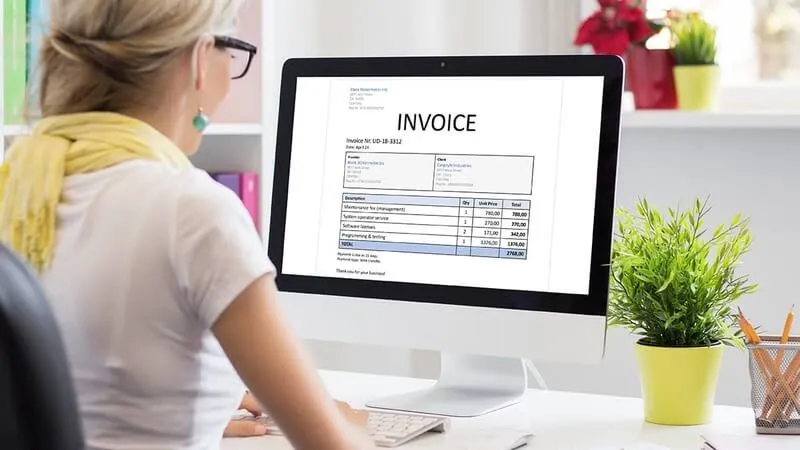1. What is invoice management?
Invoice management includes the registration, collection, backup and preservation of invoices on the archival system. For sellers, this process includes generating, invoicing, and processing payments for the purposes of financial management and accounting of the business.
Through invoice management and reconciliation, businesses can easily look up, compare and extract detailed information about financial transactions performed. At the same time, businesses can also capture the internal financial situation more comprehensively and accurately.
 Strictly manage invoices to help businesses clarify revenues and expenses
Strictly manage invoices to help businesses clarify revenues and expenses2. The role of invoice management
Invoice acts as a commercial document, but it can also be used as an accounting or tax document. Effective invoice management brings many important benefits to businesses as follows:
- Optimize resources in terms of time, human resources and opportunity costs.
- Support the process of looking up and verifying invoices, making data processing quick and easy.
- Ensure transparency in business activities of enterprises.
- Protect against the storage of invoices, prevent loss or damage from fire or failure, and meet legal requirements related to financial transactions.
 Invoice is considered as a commercial document
Invoice is considered as a commercial document3. Invoice management process
3.1 Basic invoice management
Invoice management steps need to ensure accuracy and close linkage between stages for maximum efficiency. Here is a basic process to help businesses do this work logically and effectively:
- Create Invoice: Provide full information (seller, buyer, order number, etc.) to create invoice.
- Adjust and issue invoices: Edit the information on the invoice to match the contract or customer's requirements, then issue the invoice to the customer.
- Store invoices: Record in books or backup to the enterprise's system to look up when necessary. This is the basis for controlling accounting and financial activities accurately and effectively.
- Make invoice reports: Make periodic invoice reports (weekly, monthly, quarterly or annually) to evaluate business activities and promptly handle arising issues such as revenue and expenditure differences, contract disputes buying and selling, etc
3.2 Manage e-invoices
Manage electronic invoices similar to regular invoices. However, in this process, the management and control of input electronic invoices is extremely important. According to Circular 32/2011/TT-BTC, the storage of electronic invoices requires the following requirements:
- For sellers and buyers of goods and services using e-invoices to record accounting books and prepare financial statements: E-invoices need to be stored for the period specified by the Law on Accounting. If the e-invoice is created from the system of an intermediary organization providing the e-invoice solution, this intermediary organization must also store the e-invoice during the above period.
- For sellers, buyers and intermediary organizations providing e-invoice solutions: It is necessary to back up the data of e-invoices to information storage tools such as USB, CD and DVD, hard disk or perform online backup to protect the data of e-invoices.
According to the law on storage of accounting documents, both the supplier (the seller) and the customer (the buyer) must simultaneously store the original file of the invoice in .xml format along with a copy. of electronic invoices in the form of images (.pdf, .png, .jpeg) over a period of 10 years. This ensures compliance with the law on archiving of accounting documents.
 The process of managing and using electronic invoices
The process of managing and using electronic invoices4. 5 ways to manage e-invoices for businesses
4.1 Set up a new email to receive/send invoices
To avoid confusion between job types, businesses should create a separate email to send and receive electronic invoices with customers and partners instead of using a shared email.
Advantage:
- Easily manage and categorize e-invoices, minimizing the possibility of invoices being missed and confused with other emails
- Accountants can easily manage and download electronic invoices to serve other accounting operations.
Defect:
- Verifying information when requested by customers may take more time because the professionalism of the system is not high.
- Potential risk of data loss in case an email account is lost or locked
- It is still necessary to perform manual accounting and statement steps on accounting software, which easily causes errors when entering data.
 Create a separate email to send and receive electronic invoices
Create a separate email to send and receive electronic invoices4.2 Print e-invoice email for archiving
Once created or received from a supplier, an e-invoice can be printed directly on paper for easy storage and manual management. However, the data about the e-invoice will be stored in both the email and the paper document.
Advantage:
- No need to create new emails to send and receive invoices from customers and partners
- Avoid the risk of data loss when there is an email problem because the data is stored as a paper document.
- The implementation of this solution is very simple, convenient and time-saving.
Defect:
- Printing is expensive and requires large storage space
- Accountants have difficulty in looking up and checking the validity of invoices, at risk of being lost
- E-invoices also face the challenge of validity checks as there is no formal solution for doing this.
- Accountants continue to perform manual statements and accounting, leading to errors in the data entry process
4.3 Save image of e-invoice email on computer
After creating an electronic invoice and receiving it from a supplier, many businesses often store an image of the invoice in a separate folder on the accountant's computer for easy tracking.
Normally, invoices are sorted and stored by date, month, year, supplier and invoice number to make searching and retrieval more convenient.
Advantage:
- Make, manage and store electronic invoices easier.
- Suitable for small or micro businesses with few invoices incurred in the purchase of goods and services.
Defect:
- Simultaneous operations on multiple invoices are not supported.
- The manual process is time consuming and complex.
- Invoices cannot be filtered and searched by supplier.
- Visually checking invoices can lead to errors.
- Risk of losing invoice data when the computer crashes.
- Need to manually enter data into accounting software, easy to cause errors.
 Save photo of e-invoice email on computer
Save photo of e-invoice email on computer4.4 Create an excel file listing invoice emails
Excel is popular software in managing and reconciling invoices and other jobs of many businesses. When using an e-invoice management solution , accountants can easily import data from e-invoices via email into an Excel spreadsheet for tracking and attach a link to the lookup code to the mailbox. Then, the accountant can import data from Excel to the accounting software and check and compare with the original invoice.
Advantage:
- Suitable for most accounting operations.
- Easily look up and classify invoices by various criteria such as supplier, date of purchase, type of goods or services.
- Especially suitable for small businesses.
Defect:
- The process of manually entering data from email into spreadsheets and then into accounting software can lead to a lot of errors and omissions.
- Time consuming when the number of invoices is too much
- Finding the original invoice on email and the corresponding information on the spreadsheet often takes a long time and risks leading to inconsistencies between different data sources.
- There is no automatic solution for checking invoice validity
 Create an excel file that lists invoice emails
Create an excel file that lists invoice emails4.5 Using invoice management software
Electronic invoice management software is considered the most effective solution in overcoming the limitations of previous methods of managing and storing electronic invoices. At the same time, this is also the most optimal form of management today.
Advantage:
- Save time and reduce the workload of accountants in receiving, sorting, reconciling and checking invoices
- Limit errors during manual data entry.
- Automatically check the validity of input invoices, including business information, invoices and digital signatures in invoices.
- Update data automatically and regularly, synchronizing with accounting software used by businesses.
- Easily search, look up and account for invoices when needed.
Note: To ensure efficiency in e-invoice management , businesses need to choose a highly reputable software and solution provider, use modern technology and support from a team of qualified professionals. experience in finance and accounting.












Replies to This Discussion